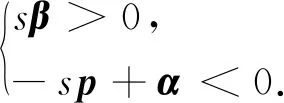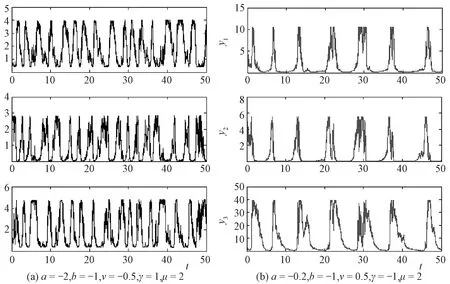Solutions of a class of stochastic Poisson systems*
WANG Yuchao, WANG Lijin
(School of Mathematical Sciences, University of Chinese Academy of Sciences, Beijing 100049, China)
Abstract In this paper, a class of stochastic Poisson systems, arising from randomly perturbing a type of Lotka-Volterra systems by certain Stratonovich white noise, are considered. We give the sufficient conditions for the almost sure existence (global non-explosion) and uniqueness of the solution of the system, and further prove that the solution is positive and bounded almost surely under the proposed conditions. Numeraical experiments are performed to verify the results.
Keywords stochastic Poisson systems; Lotka-Volterra systems; Stratonovich SDEs; invariants; non-explosion
An ordinary differential equation system is called a Poisson system[1], if it can be written in the following form

(1)
wherey∈n,B(y)=(bij(y))n×nis a smooth skew-symmetric matrix-valued function satisfying

The Lotka-Volterra (L-V) model of systems withninteracting components is given by
(2)
whereaij,bi(i,j=1,2,…,n) are real parameters. In Ref. [2], the Poisson structure of a class of Lotka-Volterra systems was analyzed, which can be
written in the form of (1) with
(3)
wherey(t)=(y1(t),…,yn(t))T,B=(bij)n×nis a skew-symmetric constant matrix, andβi≠0 (i=1,…,n). It is not difficult to check that (1) with (3) can be of the form (2).

Poisson systems under certain Stratonovich white noises perturbations, namely the stochastic Poisson systems, got attention in recent years, see e.g. Refs. [8-11], where in Ref. [9], the general form of stochastic Poisson systems was given as
(4)
whereB(y),H0(y) are defined the same way as forB(y) andH(y), respectively, for the deterministic Poisson systems (1), andHr(y) (r=1,…,m) are smooth functions. (W1(t),…,Wm(t)) is anm-dimensional standard Wiener process defined on a complete filtered probability space, and the circle ‘∘’ in front of dWr(t) denotes Stratonovich stochastic differential equations.
In this paper we consider the Lotka-Volterra systems (1) with (3) under Stratonovich white noise perturbation, of the following form:

(5)

1 A class of invariants of the system

It is not difficult to verify that
C(y)=α1lny1+…+αnlnyn

Proposition1.1LetT>0,f(x1,x2) be a binary function defined on×, andf∈C1(×). Suppose the solutiony(t) of system (5) with (3) is positive on [0,T]. Thenf(H(y(t)),C(y(t))) is an invariant of the system (5) with (3) on [0,T], whereC(y) is the Casimir function mentioned above.
ProofBy the Stratonovich chain rule, it holds on [0,T]:
(dt+c∘dW(t))=0,
where the last equality is due to skew-symmetry ofB(y), and
dC(y(t))
=0.
Thus
df(H(y(t)),C(y(t)))=
∂1f(H(y),C(y))∘dH(y(t))+∂2f(H(y),
C(y))∘dC(y(t))=0.
□
2 Non-explosion and positiveness of the solution
In the following, we will prove that the solution of the system (5) with (3) is globally non-explosive and positive almost surely. To this end, we make the following assumptions.
Hypothesis2.1Assume that for the parametersβ=(β1,…,βn)T,p=(p1,…,pn)Tof the system (5) with (3), there exist a real numbers∈and a vectorα∈KerBsuch that


ProofThe equivalent Itform of the system (5) with (3) is

(6)
Taking the concrete expressions ofB(y) andH(y) in (3) into account, it is not difficult to see that its coefficients are locally Lipschitz continuous, and then it has a unique local solutiony(t) on [0,τe), whereτeis the explosion time[12-13]. Next, we show this solution is global, i.e.,τe=+∞ almost surely. Choose an integerk0>0 such that every component ofy(0) belongs to [1/k0,k0]. For each integerk≥k0, define the stopping time
τk:=inf {t∈[0,τe):yi(t)∉(1/k,k)
for somei=1,…,n}
on the probability space (Ω,F,P). We set inf Ø=+∞, which corresponds to the case when for certaink*,yi(t)∈(1/k*,k*), for alli∈{1,…,n} andt∈[0,τe). This can only happen whenτe=+∞, due to continuity and construction ofy(t) on [0,τe)[13].

If this statement is not true, then there exist real numbersT>0 andε∈(0,1) such that
P({τ∞≤T})>ε,
which implies
P({τk≤T})>εfor allk≥k0,
since {τk,k=0,1,2,…} is an increasing random sequence. By Hypothesis 2.1, let
(a1,a2,…,an):=sβ>0,
(d1,d2,…,dn):=-sp+α<0.
Now, fory>0 we construct the function
(7)
We see thatGj(yj) (j=1,…,n) are convex functions and have minimum value 0 on (0,+∞), andGj(yj)→+∞ asyj→0 or +∞. Therefore
Gi(yi(τk))≥Gi(1/k)∧Gi(k),
whereyidenotes the element ofythat runs beyond (1/k,k) at the timeτk. Sincey(t) is positive on [0,τk∧T], according to Proposition 1.1,
G(y(t))≡sH(y(t))+C(y(t))+
is an invarint of the system on the time interval [0,τk∧T]. Then setΩk:={τk≤T}, we have
G(y(0))=E[G(y(τk∧T))]
≥E[1ΩkG(y(τk∧T))]
=E[1ΩkG(y(τk))]
>ε[Gi(1/k)∧Gi(k)].
Letk→∞ in the above inequality, we then draw the contradiction
G(y(0))>+∞.
Thus it holdsτ∞=+∞ almost surely.
□
Remark2.1When the constant matrixBis non-singular, i.e., KerBcontains only 0, the vectorαmust be equal to0, in this case, the conditions in Hypothesis 2.1 can be simply expressed asβ>0,p>0 orβ<0,p<0. Of course, this case only occurs when the system is of even dimension, since an odd-dimensional skew-symmetric matrixBmust be singular.
Remark2.2Under Hypothesis 2.1, the solutiony(t) is positive on [0,+∞) almost surely, thenf(H(y(t)),C(y(t))) given in Proposition 1.1 is a class of invariants of the system (5)with (3) on [0,+∞).
3 Boundedness of the positive solution
Based on Theorem 2.1, we can further obtain the boundedness of the positive solutiony(t).

ProofAccording to Remark 2.2, almost surely, the constructed function

Gi(yi(t))=G(y(0))-
aiyi(t)+diln (yi(t))+di-
Hence,yi(t) locates in the bounded compact set {yi∈+:aiyi+dilnyi≤G(y(0))-di+diln (-di/ai)} for alli=1,…,n, almost surely. Further, the equation of the tangent line ofGiat the pointis
Then by the convexity ofGi(yi) we obtain
Gi(yi(t))≤G(y(0)),
which implies
for allt≥0 andi=1,…,n.
□
4 Numerical validations
In this section, we simulate the solutions of two concrete models of the form (5) with (3), by the numerical method proposed in Ref. [8] for stochastic Poisson systems of the form (5), which was proved to be of root mean-square convergence order 1, and reads
(8)

4.1 A three-dimensional model
Consider the three-dimensional Lotka-Volterra system with Stratonovich white noise perturbation[8]

H(y)=aby1+y2+γlny2-ay3-μlny3.
(9)



Fig.1 Sample paths of the system (9)

In Fig.1, we take the parameterc=0.5, and the step sizeh=10-3, initial valuey(0)=(1.0,1.9,0.5)Tfor Fig.1(a) andy(0)=(1.0,1.5,0.5)Tfor Fig.1(b), respectively.
4.2 A two-dimensional model
We consider a prey-predator model[1]with random pertubation


(10)


Fig.2 Sample paths of the system (10)
Here we takec=0.5, and the initial value (u(0),v(0))=(1.5,2.5), the step sizeh=10-3.
5 Conclusion
We prove the almost sure existence (global non-explosion), uniqueness and positiveness of the solution of a class of stochastic Poisson systems, under certain hypothesis, via constructing a functionG(y) which is a special class of invariants of the systems. Almost sure boundedness of the solution is also verified. Numerical simulations give support to the theoretical results.

